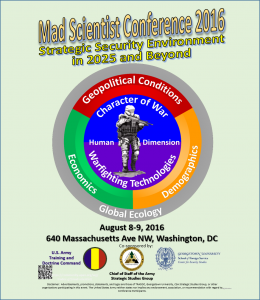(Editor’s Note: The Mad Scientist Laboratory is pleased to present our first international guest blog post from Mr. Hal Wilson of Great Britain. His post provides us with an international perspective of how speed, scope, and convergence — addressed … Read the rest
23. Extended Trends Impacting the Future Operational Environment
 The Mad Scientist Strategic Security Environment (SSE) 2050 Conference explored the thesis that the direction of global trends shaping the future Operational Environment (2030-2050), and the geopolitical situation that results from it, will lead to fundamental change in the character … Read the rest
The Mad Scientist Strategic Security Environment (SSE) 2050 Conference explored the thesis that the direction of global trends shaping the future Operational Environment (2030-2050), and the geopolitical situation that results from it, will lead to fundamental change in the character … Read the rest
22. Speed, Scope, and Convergence Trends
“Speed is the essence of war. Take advantage of the enemy’s unpreparedness; travel by unexpected routes and strike him where he has taken no precautions.” — Sun Tzu
Mad Scientist Laboratory has addressed the impact of Autonomy, Artificial Intelligence … Read the rest
21. Smart Cities and Installations of the Future: Challenges and Opportunities
“Army Installations are no longer sanctuaries” — Mr. Richard G. Kidd IV, Deputy Assistant Secretary of the Army (Installations, Energy and Environment), Strategic Integration
The Army of the future will need installations that will enable strategic support areas critical to … Read the rest
20. Building Future Ready Organizations
During the 2017 Mad Scientist Conference on Robotics, Artificial Intelligence and Autonomy at Georgia Tech Research Institute, notable futurist Dr. James Canton challenged the audience with an interesting question, “Are your organizations future ready?” It seems this simple question drives … Read the rest
